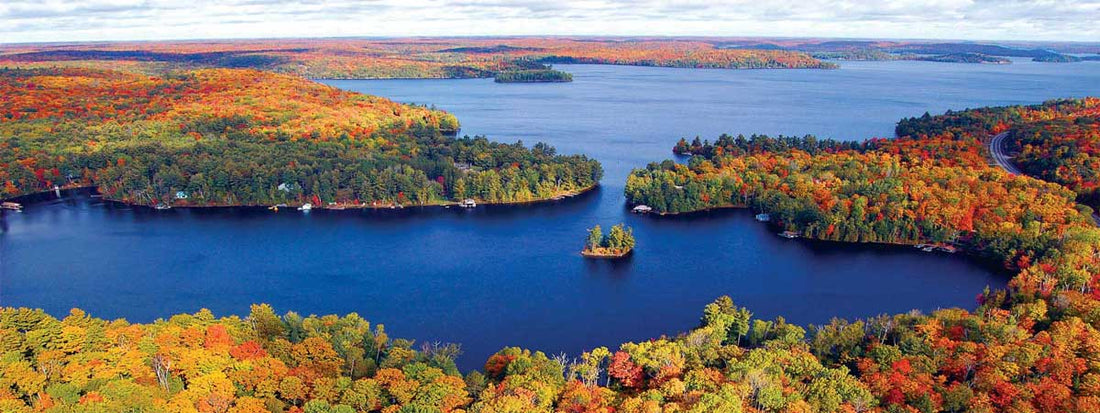Ideal sites like this are what everyone strives for however it’s important to take a closer look at the details before pulling the trigger on the biggest investment of your glamping business. (image credits)
- This is as much a real estate investment as it is an ecotourism and hospitality business
- There is no perfect property, align your budget with low risk sites and improve them for the long term
- Use map resources to look at the elevation, water and geology of your prospective site
- Do a site visit to look at the state of the forest and areas which might not be apparent in pictures
Why is land important?
A glamping business where the site is owned, is also a real estate investment. It can be seen as a profit multiplier. Good land will drive more customer traffic to the business while simultaneously having a higher appreciation rate.
As glamping businesses tend to fall into the realm of ecotourism, a pristine natural environment is the ideal site. Our own public surveys as well as those of others also show that people are drawn to water (especially in the peak summer months of this industry). Having direct water access would be another profit multiplier.
As we mentioned in a previous article (insert link), the success of a glamping business can be directly influenced by the available activities on site/in the surrounding area. Naturally, water provides the medium for a lot of high value recreation.
However, many sites that lack standout features like water are still very successful. This is because in a long term project such as a glamping business, land can be improved so that there is higher natural value. For example, a site that has been deforested and degraded for pasture land can be improved by planting native trees and restoring natural water flow via wetlands and streams. Hiking and cross-country ski trails can also be built to enhance the offering of on site activities.
Having a long term strategy for improving your land in important because it goes hand in hand with what the ethos of a glamping business should be. We want to create a space where people can enjoy and explore nature while still generating a sustainable return for the efforts of creating and managing this endeavour.
Many ecological restoration projects rely on funding as they do not generate revenue. A glamping business can solve this problem with it’s ROI creating the self sustaining means to execute ecological restoration and acting as an incentive to further continue it.
What should be avoided?
The typical mental image is of a large plot of land with mature trees, water access and a gentle slope. While this is tempting, in reality it is more of a unicorn than something common at a reasonable price point.
There are many factors from accessibility to zoning laws that quickly narrow down options that are feasible.
Let's start with the geographic considerations.
Water
Too little and too much are both problems. While we mentioned previously that not having a body of water on site isn’t a dealbreaker, not having access to groundwater can be.
As many of these properties are rural by nature, having a connection to municipal water services is often the exception instead of the norm. In this case, a water well would be needed as a solution to service guests reliably. If the water table is too shallow then the quality suffers. Too deep and rocky would result in very high costs to extract the water.
While having river or lake access is a huge win, you must be sure to check the flood risks. Building of structures in usually banned within the limits of 25 or 50 year floods. In the event that semi-permanent structures like domes are not covered by regulation we still recommend to avoid building here. Instead, a better focus would be to develop attractive riparian ecosystems and recreational spaces for activities.
Swamps are also to be avoided. Many sites for sale look great in pictures only for you to discover that those photos are from the 10% of the site that is not flooded for 10 months of the year. Low lying sites such as those on swamps are usually protected as conservation land which restricts building. Even if they aren’t, building anything becomes more expensive and difficult. Finally, swamps have high concentrations of mosquitos and less space for activities. This reduces guest enjoyment.

Diagram of a standard well. https://www.ontario.ca/page/private-rural-water-supplies
Earth
Having a rocky site is definitely not a dealbreaker. In fact, it can enhance the natural beauty of your site by highlighting the Canadian shield geography that people are seeking. It can increase costs however. Infrastructure that intends to go through the path of shield will incur higher costs. Furthermore, drastic changes in elevation can create safety hazards. This can lead to the need for more infrastructure and less usable space.
Fire and Felling
Forest management is an important factor. Many degraded sites with dense trees can become hazards for forest fires in dry periods. Some level of forestry management may be required of the land owner. In areas that guests will use, dead or dying trees would also be hazards if they fall. Removing trees can be a large expense so when viewing a potential site it is important to inspect the trees in key areas and the state of the forest at large.
Takeaway
To find these site issues before wasting too much of your time we recommend: using satellite imagery to view the site, locating open source maps for geographic variables and paying for a survey to be done or (with the information provided in this article and others) conducting your own.
Resources
https://ontariogroundwater.com
https://www.ontario.ca/page/forest-management-guides
https://www.ontario.ca/page/wells-your-property
https://www.orillia.ca/en/doing-business/resources/Invest-Downtown-Orillia/OLC-GlampingOutdoor-Adventure-Opportunity.pdf

